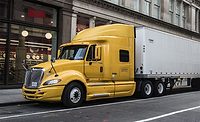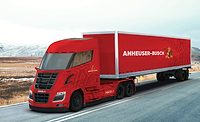Beverage fleets make room for low-cab-forward configurations
Cabovers support urban growth, push for electric vehicles

The term “cabover” or “cab over engine” (COE) typically evokes a sense of nostalgia within U.S. commercial fleets, as they had a much greater presence on the road in a bygone era. The 1950s to the 1970s could be considered the Golden Age of the cabover as laws of the time capped a truck’s total length at 65 feet, prompting manufacturers to place the cab above the engine to save some valuable horizontal footage. The cap was removed in 1976, enabling truck lengths to expand by nine feet and essentially ushering in the era of what we now call the conventional configuration.
Although cabovers remain the dominant format in Europe — trucks across much of the continent have a maximum length just shy of 62 feet — they’re mostly a niche here in the States. But that niche could be widening as fleets recognize one-size-does-not-fitall in delivery environments or vehicles. For one thing, they’re known for their greater maneuverability and visibility on narrow streets and around tighter corners, making them attractive for operations that serve urban markets.
The cabover’s compatibility with city streets also has marked them as good candidates for electrification. The frequent stop-and-start and idling that are characteristic of urban driving have made such environments a common target for battery electric truck deployment. That’s one of the key reasons PACCAR is offering its zero-emission Kenworth K270E class 6 and K370E class 7 electric cabover vehicles.
“Kenworth is committed to providing advanced electric vehicle technologies and the medium-duty K270E and K370E electric trucks are a major step forward,” says Kenworth general manager and PACCAR vice president Kevin Baney. “Our popular and proven cabover platform now offers fully integrated, state-of-the-art electric powertrains combined with exceptional visibility and superior maneuverability.”
In other cabover news, Hino recently announced the release of its new class 4/5 M Series. The 2021 models have been upgraded with an all-new grill design, complete with optional LED headlights and an HD 6 speed Aisin automatic transmission with gear hold feature. Available with a fully integrated lane departure warning system, the 2021 model features interior upgrades such as a new shifter layout and steering wheel controls, and an all-new gauge cluster that includes a 4.2-inch LCD multi-information display and driver’s seatbelt display.
Yet, we can’t talk about cabovers without checking in with Isuzu Commercial Truck of America. The supplier hit a major milestone this year with the opening of its Casper, Wyo., dealership — making Wyoming the 50th U.S. state in which Isuzu operates dealerships. It now has 297 full-line dealerships and 13 service-only facilities across the United States.
Isuzu has been active in the beverage space. Last year, the company, in collaboration with body manufacturer Supreme, unveiled a truck specifically designed for craft beer distribution, the temperature-control upfitter Delivery Concepts and Anaheim, California craft brewer Bottle Logic. The chassis on the unit is an Isuzu NRR cabover with a 19,500 gross vehicle weight rating (GVWR), attached to a Supreme Kold 16-foot insulated body, a 2,500-pound Maxon liftgate, two 24-inch-by-24-inch tool boxes and a working eight-tap draft system. LED lights illuminate the taps and offer a clean, high-tech appearance. Isuzu says the combination of economy, power, maneuverability and low cost of ownership made the NRR the ideal option for the craft beer truck.
Looking for a reprint of this article?
From high-res PDFs to custom plaques, order your copy today!







